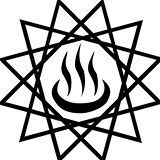by Melissa edited by various authors
(6 & 7 Thargelion) In Athens, the 6th of any month was usually devoted to Artemis, and the 7th to Apollo, possibly because Artemis was believed to have been born on the 6th of Thargelion and Apollo on the next day. However, in Thagelion, these days are also associated with special festivals. The name of the month comes from the name of the festival, Thargelia, which in turn comes from thargelos, a form of sprouted grain bread, probably made of barley. This is because May sees the first harvest of the green cereals, which were offered to Artemis (and later Demeter and/or Dionysos) as ta thalusia, from the word for “young shoot” or sprouting greenery, thallos (Liddell and Scott).
Apparently, Thargelia was celebrated in similar ways in many Ionic cities (Parke 146), cities with a cultural affiliation with Athens, suggesting an ancient origin to this festival.
Parke (25) says that on Thargelion 6, bad things are driven out, while on Thargelion 7, good things are carried in.” In Festivals of the Athenians, Parke says: that the 6th was a day or purification and the 7th was a day of offerings. In the Iliad (I.314), the plague of the Greek camp is attributed to Apollo, and the men have to clean themselves, purify themselves, and cast the dirt into the sea; then they make offerings (148). In myth, Apollo is associated with plague, his arrows shot from afar thought to bring dire disease, but at the same time, he is the god of healing and restraining pestilence. Burkert notes that “the averter of threatening dangers is Apollo; elsewhere he has to keep away mice, as Smintheus, locusts, as Parnopios, and corn rust, as Erysibios” (265). The main focus of the two-day observance seems to be the obviation of disease.
In Athens, some time prior to the Thargelia, two men were chosen for their ugliness and poverty and fed at public expense. These two men, one to represent the Athenian men and one for the women, were known as pharmakoi, “scapegoats”, a term related to the word for sorcerer or poisoner, pharmakeus. On the first day of the Thargelia, the scapegoat for the men was adorned with a string of black figs and the scapegoat for the women was given a string of white figs. They were taken in the festival procession around the city, then beaten with fig branches and pelted with the hard bulbs of the squill plant (squill was known as a pharmikon, a drug, for its emetic and skin irritation properties) and eventually driven out of the city. It is possible that, at one time, they were treated with greater harshness as part of a katharsia, a purification sacrifice (Burkert 83).
The second day of the Thargelia involved a special offering to Apollo, as guardian of the crops of the field. This is the thargelos, a first-fruits offering, made by boiling grains and other vegetables in a pot (Parke 147). This is a similar offering to that of Pyanepsia, at which another panspermia is cooked and given to the god. But the Pyanepsia was linked to the time of seeding the fields and the Thargelia to the earliest harvest (Parke 147). Apollo is more commonly known as the god of music and hymns, and the archon of Athens was required to provide for hymn-singing contests for men’s and boys’ choirs; the winners received a tripod, which they then dedicated to the God in the Pythion, Apollo’s temple near the Ilissos (Parke 147).
Burkert (101) mentions that, at some time during Thargelia (and also at Pyanepsia), children would form a procession traveling throughout the city, garnering gifts. “They carry an olive branch wreathed with fillets of wool and laden with numerous firstlings, fruits of all kind, bread, and little flasks of oil. The branch is called Eiresione, and they sing: The Eiresione brings figs and fat bread, honey in pots, and oil to rub down, a cup of strong wine so you go drunk to bed”.
This festival was the time at which new children were introduced by their fathers to the family’s phratria (tribe). This is because Apollo was accepted in Athens as Apollo Patroös (ancestral god) because in myth he is said to be the father of Ion, the eponymous ancestor of the Ionians and thus of the race to which the Athenians belonged. Apollo is also associated with the growth and rearing of boys (Parke, p. 148-9).
Lastly, the first day of Thargelia was date on which a ram was offered on the Acropolis to Demeter Chloe (green goddess).
Note: Helene P. Foley, in her background article on the Eleusinian Mysteries in her edition of The Homeric Hymn to Demeter, states that “all important rites of Demeter in Attica seem to have been linked (at least loosely) to stages of the agricultural year (71). Moreover, these festivals seem to have a connection with some part of the Homeric Hymn, especially since Eleusis, which was incorporated into Attica, was the site of much of the narrative of the Hymn. Thus Thargelia is part of the sacred festival cycle of grain in ancient Greece, along with the Proerosia (Oct), Thesmophoria (Oct), Haloa (Dec), the Lesser Mysteries (Feb), Skirophoria (June) and the Eleusinian Mysteries (September).
To celebrate this festival today:
To celebrate this festival, on the first day, pour a wine libation, read the Homeric Hymns to Artemis (9 and 27) and the Orphic Hymn (36) to Artemis, and offer prayers to her. It is also a day to undergo catharsis, so it might be appropriate to undertake a ritual fast (abstaining at least from animal foods) and bath and other forms of purification for yourself. Before hand, clean house, carry out household trash and any food that is stale or no longer pure or fresh (good fridge-cleaning opportunity!). On your altar, place some of the “first fruits” of your region, especially cereal gains, if available (you can plant and grow some in a small pot in the last fall or winter so as to have some available for this festival).
Around sundown, either reuse the eiresione created for the fall Pyanepsia or create a new eiresione and prepare a panspermia (mixture of beans or grains and beans with vegetarian broth). The eiresione was, in ancient times, a branch of olive; if this isn’t available, use some other domestic, fruit-bearing species. Decorate the branch with strands of white wool (like the branch carried by suppliants) but also with “first fruits” (which might vary, depending on what area you live in). Shafts of green wheat in one area and tree fruit in another. You can add little containers of oil and honey, too. Another food item to buy or create is called “manna bread” to represent the thargelos (see above). “Manna bread” (available in many health food stores) is a non-baked loaf made of sprouted grains.

This is a particularly communal festival, with family if possible. If children are present, have them carry the erisesione and recite, with your help: ‘Eiresione brings / All good things / Figs and fat cakes to eat / Soft oil and honey sweet / And brimming wine-cup deep / That she may drink and sleep.’ If no children are present, anyone can do this. Whether child or adult, they ask for treats from others present. On this second day, honor Apollo with a libation of wine, read the Homeric Hymns to Apollo (3 especially, also 21 and 25) and the Orphic Hymn to Apollo (34) and even the Orphic Hymn 35 to Leto. If a burning sacrifice is possible, burn the Eiresione and offer some of the panspermia and manna bread. At the festive meal afterwards, eat the panspermia and manna bread. Provide stalks of oregano and other seasonings for each person to season the bowl of panspermia as they wish. Some of the panspermia can be retained to sow into your gardens or fields. If no burning sacrifice is done, compost the eiresione and panspermia or put in a respectful location where nature will accept it.
Sources:
Burkert, Walter, Greek Religion, English version 1985
Foley, Helene P., ed., introduction, Homeric Hymn to Demeter, Princeton, 1994
Liddell and Scott, Greek English Lexicon, 3rd ed
Parke, H.W., Festivals of the Athenians, 1977
A sample Thargelia ritual can be found here.
